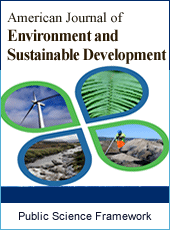American Journal of Environment and Sustainable Development
Articles Information
American Journal of Environment and Sustainable Development, Vol.6, No.1, Mar. 2021, Pub. Date: Mar. 17, 2021
Viability of Wood Dust Biomass of Ahun (Alstonia congenisis Engl.) for Solid Fuel Production
Pages: 34-39 Views: 1597 Downloads: 294
[01]
Helen Olayinka Ogunsuyi, Department of Chemistry, School of Sciences, Federal University of Technology, Akure, Nigeria.
[02]
Waliyu Adedeji Oyebode, Department of Chemistry, School of Sciences, Federal University of Technology, Akure, Nigeria.
Nigeria has a vast amount of agriculture and forest residues that are grossly underutilized. The potentials of these biomasses considered as wastes can be tapped for energy generation. Therefore, the present study investigated the viability of wood dust biomass (Astonia congenisis) as feedstock for solid fuel production using a thermo-chemical conversion process such as Torrefaction process. The process was performed with an improvised torrefier. The effect of the torrefaction process on the fuel properties of the biomass was evaluated by performing the Fibre analysis (cellulose, lignin, hemicellulose), Proximate analysis (moisture content, volatile matters content, ash content, fixed carbon), Ultimate analysis (nitrogen content, carbon content, hydrogen, oxygen and sulphur content) and Energy value before (untorrefied) and after (torrefied) the torrefaction process. From the result, the energy value of 19.58 MJ/kg recorded for the untorrefied sample remarkably increased to 27.28 MJ/kg upon torrefaction at 200°C process temperature. The lignin content of the biomass increased from 30% to 64% after torrefaction. A slight increase from 39% to 40% was observed in the cellulose content of the biomass upon the thermo-chemical process. However, hemicellulose, extractives and holocellulose which were 28%, 10.50% and 67% respectively in the untorrefied sample decreased to 24%, 8.50% and 64% respectively upon torrefaction. The moisture content in the untorrefied biomass decreased from 22.50% to 17.50% after the torrefaction process. This observation was also noticed in the volatile matter composition of the biomass. Conversely, the ash content of the sample was discovered to be 2.00% in it untorrefied form and increased remarkably upon torrefaction to 4.00%. Furthermore, 17.50% fixed carbon was detected in the untorrefied (raw) biomass sample and was noticeably increased to 40.50% after torrefaction. These observations implied that torrefaction method is an effective thermo-chemical conversion process for solid fuel production from wood biomass due to its enhancing fuel properties potentials.
Biomass, Torrefaction, Bio-coal, Fossil-sourced Fuel, Wood Dust, Alstonia congenisis, Sustainable Energy
[01]
Mohan, D., Pittman, C. U and Steele P. H. (2006). Pyrolysis of Wood/Biomass for Bio-oil: A Critical Review, Energy & Fuels, 20: 3 pp. 848–889.
[02]
Fonseca, F. F., Luengo, C. A., Bezzon, G and Soler, P. B. (1998). Bench unit for biomass residues torrefaction. Proceedings of Conference on Biomass for Energy and Industry, Würzburg, Germany, June 8–11, 1998.
[03]
Chen W. H., Zhuang Y. Q., Liu S. H., Juang T. T., Tsai C. M. (2016). Product characteristics from the torrefaction of oil palm fiber hydrothermal carbonization pellets in inert and oxidative atmospheres. Bioresource Technology, 199: 367–374.
[04]
ASTM D5865-04. (2004). Standard test method for gross calorific value of coal and coke. ASTM Int. West Conshohocken, PA, Available from: www.astm.org.
[05]
ASTM D-3173-03. (2018). Standard test method for moisture value in the analysis of coal and coke. ASTM Int. West Conshohocken, PA, Available from: www.astm.org.
[06]
Duranayneslihandeveci and nazlicayci (2019) Production of solid fuel with Torre faction from agricultural wastes. Researche on engineering structures and materials, 5 (3): 311-320.
[07]
ASTM D-3175. (2018). Standard test method for volatile in the analysis of coal and coke. ASTM Int. West Conshohocken, PA, Available from: www.astm.org.
[08]
Nyoman Sukarta, Dewa Ketut Sastrawidana and Nip Utu Sri Ayuni (2018). Proximate analysis and calorific value of pellets in biosolid combined with wood waste biomass.
[09]
ASTM D-3174 (2018). Standard test method for ash value in the analysis of coal and coke. ASTM Int. West Conshohocken, PA, Available from: www.astm.org.
[10]
TAPPI-204cm-97 (1997). Solvent Extractives of Wood and Pulp.
[11]
TAPPI-222 cm-02 (2002). Acid Insoluble Lignin in Wood and Pulp.
[12]
Wise, L. E., Murphy, M., Daddieco, A. A. (1946). Its Fractionation and Bearing on Summative Wood Analysis and on Studies on the Hemicelluloses. Technical Association Papers; 29 (6): 210-8.
[13]
Kurada, K., Mokuzaibunseki. In: Yoshida H, editor (2000). Mokushitsukagakujikken manual, Tokyo: Buneidoshuppan; p. 87-98.
[14]
Akande, O. M and Olorunnisola, A. O. (2018). Potential of briquetting as a waste management option for handling market-generated vegetable waste in port-harcourt, Nigeria. Recycling 2018, 3 (2), 11; doi: 10.3390/recycling3020011.
[15]
Akogun O. A., Waheed M. A. (2019). Property upgrade of some raw Nigerian biomass through torrefaction pre-treatment. J. Phys: conf. ser. 1378 032026.
[16]
Uslu A., Faaji A., Bergman P. (2008) Pre-treatment technologies, and their effect on international bioenergy supply chain logistics. Techno-economic evaluation of torrefaction, fast pyrolysis and pelletisation. Energy, 33, 1206-1223.
[17]
Sadaka S and Negi S. (2009). Improvements of Biomass Physical and Thermochemical Characteristics via Torrefaction Process. Environmental Progress & Sustainable Energy. 28: 3, pp. 427–434.
[18]
Bergman P. C. A. and Kiel J. H. A. (2005). Torrefaction for Biomass Upgrading. Published at 14th european Biomass Conference & Exhibition, Paris, France, October 17–21, 2005.
[19]
Pastorov I., Arisz P. W., and Boon J. J. (1993). Preservation of D-Glucose Oligosaccharides in Cellulose Chars. Carbohydrate Research, 248, pp. 151–165.

ISSN Print: Pending
ISSN Online: Pending
Current Issue:
Vol. 6, Issue 4, December Submit a Manuscript Join Editorial Board Join Reviewer Team
ISSN Online: Pending
Current Issue:
Vol. 6, Issue 4, December Submit a Manuscript Join Editorial Board Join Reviewer Team
| About This Journal |
| All Issues |
| Open Access |
| Indexing |
| Payment Information |
| Author Guidelines |
| Review Process |
| Publication Ethics |
| Editorial Board |
| Peer Reviewers |


